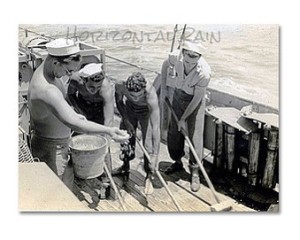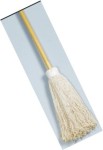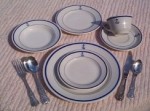By Randy Steffen, 6th Division, 1958-61
Some US Navy Sailors go through an entire enlistment or career without screwing up one time. Unfortunately, I didn’t enjoy my first enlistment unscathed from being corrected in observing proper conduct and attention to my responsibilities. These shortcomings were eventually (painfully) overcome due to the wise administrations of my Division Petty Officers.
I had a vivid imagination of what discipline in the Navy might be like.
One morning, after quarters, I was called to the deck gear locker and informed that I had been assigned to three months of mess cooking duties. After quarters my shipmates went, “Oh Oh Randy, who did you get PO’d at you?” Worried that I might have done something wrong, I made a resolution that I would do the best job I could and (somehow) get back in favor, for whatever I might have done. At the time, it hadn’t occurred to me that mess cooking was a normal rotation of duties that was shared by most of the Division.
I was assigned to duty in the scullery and I discovered the work was not that bad. The scullery was inspected often for cleanliness and proper operation and we never failed an inspection and we received several Bravo Zulu’s for our efforts. One of the mess deck Master at Arms, a BM/2, Boats, was great to work for and helped me with my studies.
One evening after the mess decks had secured, the scullery machine was clean and the brass piping inside was made to gleam by running powdered drink (bug juice) mix through the system with hot water, I thought, “there might be ancillary use and benefit of this dish washing machine.” When the machine is operating, everything to be washed is placed on perforated plastic racks to pass though the machine in a wash cycle. My Great Idea. This might be able to wash white hats.

 I went down below to my locker and collected six white hats. Back in the scullery I filled the machine with hot water and placed the hats on the plastic racks (two hats to a rack) and started the washing process. After about five seconds of operation the BM/2 walks in and seems to be in the mood to talk. To this day I don’t remember what the conversation was about. All the while, the washing machine was steadily chug-chugging the racks with my white hats on the racks through the machine. When Boats saw the first of my hats come out of the finish side of the machine, his face turned purple, his eyes bugged out and he grabbed me and with the broad side of his shoe he kicked me hard in my hip pockets. All I could think of was, “Here I am in deep kimchi.”
I went down below to my locker and collected six white hats. Back in the scullery I filled the machine with hot water and placed the hats on the plastic racks (two hats to a rack) and started the washing process. After about five seconds of operation the BM/2 walks in and seems to be in the mood to talk. To this day I don’t remember what the conversation was about. All the while, the washing machine was steadily chug-chugging the racks with my white hats on the racks through the machine. When Boats saw the first of my hats come out of the finish side of the machine, his face turned purple, his eyes bugged out and he grabbed me and with the broad side of his shoe he kicked me hard in my hip pockets. All I could think of was, “Here I am in deep kimchi.”
 For a moment, I thought Boats was going to strangle me, but then he calmed down and called me more names than I have ever heard at one time. He ask me if I would ever do such a “@%*)&!@#“ thing as that again? Rubbing my hip pockets, I promised, “no Boats, I won’t.” He didn’t report me and we got along well after that.
For a moment, I thought Boats was going to strangle me, but then he calmed down and called me more names than I have ever heard at one time. He ask me if I would ever do such a “@%*)&!@#“ thing as that again? Rubbing my hip pockets, I promised, “no Boats, I won’t.” He didn’t report me and we got along well after that.
The day before I was relieved from mess cooking, Boats came down to my berthing compartment and said, “Randy, the next time at sweepers, never ask for a MOP.” “Always ask for a swab.” He went on to say, “A mop has a detachable head and a swab doesn’t.” “We don’t have any mops in the Deck Department.” I asked, “Is that why I was sent mess cooking?” Boats shrugged his shoulders, smiled and just walked away. Well, I never made that verbal mistake again.
“Clamp Down All Weather Decks”
???????????????????????????????????
The first time I heard this order, I didn’t have a clue about what the order meant. All kinds of mental pictures were going through my mind. I learned that after sweeping down the deck, a man would follow along behind with a bucket of water and dampen down the teak wood deck. We would then swab down, removing any residual dust left by the brooms.

One thing noticeable on U.S. Navy Ships, the decks are kept as clean as possible.

Here I was, just 17 years of age and very proud to be a United States Navy Sailor on a Man O’ War, the USS Rochester CA-124
Swab, Swab – Those Darn Swabs
I really tried to do the best I could but being a scatter-brained teenager, I seemed to be prone to messing up from time to time ….without even half trying. I did learn early on that it was not wise to call a swab a mop and then laugh when corrected. Was that misspoken word the cause for me being assigned to three months mess cooking duties early on in my career? No one would ever say but I learned to keep my Scuppers tightly shut after that!
 Oh boy, things were going well and I was learning my rate fast and in general, enjoying myself. While underway, a routine job was to clean the Division swabs by securing four or five together with six thread line and from the fantail, let them stream out in the ships wake for about 10 minutes.
Oh boy, things were going well and I was learning my rate fast and in general, enjoying myself. While underway, a routine job was to clean the Division swabs by securing four or five together with six thread line and from the fantail, let them stream out in the ships wake for about 10 minutes.
Another Seaman and I were assigned to this task of cleaning Swabs it was one of those jobs where you could relax a bit and Perhaps smoke a cigarette. As I recall, while the swabs were being cleaned in the ships wake, we decided to go over and look at the Captain’s Gig that was deck loaded near the stern. The Gig was a beautiful craft with sparkling chrome and fancy work. We were enjoying ourselves to the extent that we forgot about the swabs streaming over the fantail. Oh no! When we hauled the swabs back aboard, there were (maybe) four or five strings left on each swab. We knew we were in deep kimchi but we had to own up to it with our PO. Yep we got chewed out and thought that was the end of it. WRONG! I was glad to put my screw up behind me and carry on and I expected to get more of the less desirable jobs like scrubbing out the bilges on the motor whale boat and those jobs came in a bunch.
 We all know that at Non Judicial Punishment (Captains Mast) the Skipper may restrict a person to the limits of the ship for a period of time. No other person has that the authority …HUH? When we returned to our home port in Long Beach, like most in the liberty section I was anxious to go ashore. In my liberty uniform I went to the Duty Petty Officer for my liberty card. He took the cards from his pocket and looked through them several times and finally said, “Steffen, your card isn’t here.” He then checked with the other PO’s and they didn’t have my card. He directed me to the personnel office to Inquire if it was there. No, they didn’t have it. I ask the PO, “what should I do now?” He told me to stay aboard and he would “look into it in the morning.”
We all know that at Non Judicial Punishment (Captains Mast) the Skipper may restrict a person to the limits of the ship for a period of time. No other person has that the authority …HUH? When we returned to our home port in Long Beach, like most in the liberty section I was anxious to go ashore. In my liberty uniform I went to the Duty Petty Officer for my liberty card. He took the cards from his pocket and looked through them several times and finally said, “Steffen, your card isn’t here.” He then checked with the other PO’s and they didn’t have my card. He directed me to the personnel office to Inquire if it was there. No, they didn’t have it. I ask the PO, “what should I do now?” He told me to stay aboard and he would “look into it in the morning.”
Since I had been in hot water over the ruined swabs, I didn’t want to make too much of a fuss. The next day I asked about my liberty card and after a search, no one could find it. In the mean time I learned that, without going to CO’s Mast, the personnel office may take up to two weeks to replace a LOST liberty card … BEING BUSY LIKE THEY ARE. I stayed aboard for two more liberty days when the Leading Division Petty Officer called myself and the other ‘swab killer’ to the deck gear locker and handed us our liberty cards. I didn’t want to ask where the cards had been. We hooted and hollered all the way down to our compartment to get ready for liberty.
Those two separate FUBAR’S with the swabs brought me to the realization that I needed to shape up and square myself away. Much later, when the ship was going through decommissioning I learned that the Leading PO had placed our liberty cards in his jumper pocket and taken them ashore during those dark days. Truly, our liberty cards
could not be found and they were not aboard. I suppose one could say my leaders were teaching my buddy and I Responsibility without the necessity of resorting to CO’s Mast that would have been harmful to our careers.
Fortunately, I learned many important lessons about duty and responsibility aboard Rochester that I carry with me to this day. Given my bumbling ways, I was able to complete a career spanning 22 years and transferred to the Fleet Reserve as a Senior Chief Boatswain Mate.

 Most of the Officers and men I was privileged to have worked for and with adhered to the axiom that, “Problems are often best handled at the lowest level.”
Most of the Officers and men I was privileged to have worked for and with adhered to the axiom that, “Problems are often best handled at the lowest level.”
Sluffing Off Has It’s Own Rewards
From time–to-time I see something that reminds me of an experience aboard Rochester. The object that brought back memories of holystoning was a sand stone brick some mason’s were using on a landscaping project. Ah yes, I remember quite well holystoning Sixth Division’s teak wood decks. One beautiful Friday morning I mustered with the Division at our deck gear locker to be issued my stick (old swab handles). I was pleased to be issued a much used, light stone. Happy with my good fortune I lined up with my mates and we commenced the routine, 20 licks (strokes) to the board and 30 licks to the sister board. The sister board is located outboard next to the waterway.
When we shifted holystoning to the third board, my stick broke through the bottom of the stone and boy oh boy, stoning became very easy! What I did not realize was that the stick was leaving a distinctive mark in the sand and sugi. Sugi is a secret concoction of shaved salt water soap, bright work polish, boiler compound salt water and what ever else they could find to give it a cleaning kick.
Well, the Second Class Boatswain Mate observed this terrible crime and knew exactly what was going on. Like most Boatswain Mates, he had a vengeful sense of humor and with a stern look on his face, he relived me of my stingy stone with a hole all the way through and issued me a brand new (heavy) stone. Oh my aching back.
There I go again, in deep kimchi, up to my rolled-up dungaree legs. For a couple of months after that guess who was issued a brand new, never used holystone? I was also given the privilege of hauling buckets of sand from the sand locker.
My discipline learning curve was, at times, rather flat lined and most likely because my thinking must have been located somewhere between my knee caps and belt buckle. Thankfully, corrective guidance from my leaders served me well.
 Prior to tile being laid down (allowed) in the berthing compartment’s passageway aboard Rochester, the decks were mostly bare steel. Some areas under the bunks, lockers and around ammo hoists, were neatly painted to make cleaning easier. As can be imagined, the bare, high carbon steel decks would get a haze of rust rather quickly, especially after sweeping and swabbing down. When the rust haze appeared, the Johnson Bar could be used to remove that fine film. After tile was laid throughout the compartments, the Johnson Bar was used to buff and polish the waxed tile. I didn’t know during this period there was such a thing as an electric buffing machine.
Prior to tile being laid down (allowed) in the berthing compartment’s passageway aboard Rochester, the decks were mostly bare steel. Some areas under the bunks, lockers and around ammo hoists, were neatly painted to make cleaning easier. As can be imagined, the bare, high carbon steel decks would get a haze of rust rather quickly, especially after sweeping and swabbing down. When the rust haze appeared, the Johnson Bar could be used to remove that fine film. After tile was laid throughout the compartments, the Johnson Bar was used to buff and polish the waxed tile. I didn’t know during this period there was such a thing as an electric buffing machine.
The Essential Navy Hand Scrub Brush
 Used from Day One of Recruit Training, this simple brush served many sailors well during their career. This simple but sturdy brush was excellent for scrubbing white hats and cleaning those hard-to-reach areas during Field Days. An incident that happened several times during my career, but did not participate in, involved sailors that would not take proper care of their personal hygiene. They would be labeled as a “scrounge”. Usually the scrounge would receive several warnings to clean themselves up. If that didn’t work, sometimes crew members would take the matter into their own hands, and late at night, some stalwart sailors would escort the smelly scrounge to the showers and with this handy brush, scrub him down. If this failed, the chain of command would be utilized starting with a visit to sick bay, warnings from the Division Officer and perhaps the XO. If nothing worked, Captain’s Mast. I never knew of anyone going all the way to Mast for being unclean but should that extreme become necessary, I understand a person might be discharged. All too often personnel problems can best be solved at the lowest level. I am sure that sometimes the Division Officer would be become aware of this “corrective action”, but would not let on that he knew.
Used from Day One of Recruit Training, this simple brush served many sailors well during their career. This simple but sturdy brush was excellent for scrubbing white hats and cleaning those hard-to-reach areas during Field Days. An incident that happened several times during my career, but did not participate in, involved sailors that would not take proper care of their personal hygiene. They would be labeled as a “scrounge”. Usually the scrounge would receive several warnings to clean themselves up. If that didn’t work, sometimes crew members would take the matter into their own hands, and late at night, some stalwart sailors would escort the smelly scrounge to the showers and with this handy brush, scrub him down. If this failed, the chain of command would be utilized starting with a visit to sick bay, warnings from the Division Officer and perhaps the XO. If nothing worked, Captain’s Mast. I never knew of anyone going all the way to Mast for being unclean but should that extreme become necessary, I understand a person might be discharged. All too often personnel problems can best be solved at the lowest level. I am sure that sometimes the Division Officer would be become aware of this “corrective action”, but would not let on that he knew.









